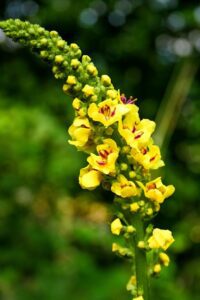Mullien Click to listen highlighted text! Mullien :
Mullein has a long medicinal herbal history.
Early on, this herb attained a reputation as a Native Americans used to inhale smoking leaves to relieve congestion.
Native Americans used to inhale smoking leaves to relieve congestion.
Research says it soothes not only the respiratory tract but also the digestive system. You can also crush a few leaves in your hand and apply it on stings and scrapes as a poultice. It’s soothing.
The medicinal plant known as common mullein (Verbascum thapsus L.) has been used to treat migraine headaches, spasmodic coughs, asthma, and inflammatory disorders.
It helps evacuate mucus by acting as an expectorant. Herbs that act as expectorants aid in bronchial secretion lubrication and facilitate mucus excretion.
The Plant:
Mullien grows almost everywhere – commonly found along highways, in meadows, and in pasturelands. It has velvety leaves, a rod-like stem and beautiful yellow flowers.
Mullien Tea & Tincture:
To brew a medicinal cup of tea, use 1 to 2 teaspoons of dried leaves per cup of boiling water. Steep for ten minutes. Drink up to three cups per day.
It has a bitter taste, so you may want to add sugar or honey and lemon, or mix it with other herbs.
In a tincture, take 1/2 to 1 teaspoon up to three times a day.
Traditional uses of the herb suggest 3 to 4 grams of flowers, 15 to 30 mL of fresh leaf or 2 to 3 grams of dry leaf.
Precautions:
There have been no reliable reports of any severe adverse effects, and mullein leaves and blooms are on the FDA’s GRAS (generally recognized as safe) list.
However there is this exception: some mullein species may result in contact dermatitis, a skin reaction that can itch, rash, and irritate the skin. Before applying mullein to your skin, make careful to conduct a patch skin test if you have sensitive skin or are prone to allergic reactions.
See also Lobelia.
